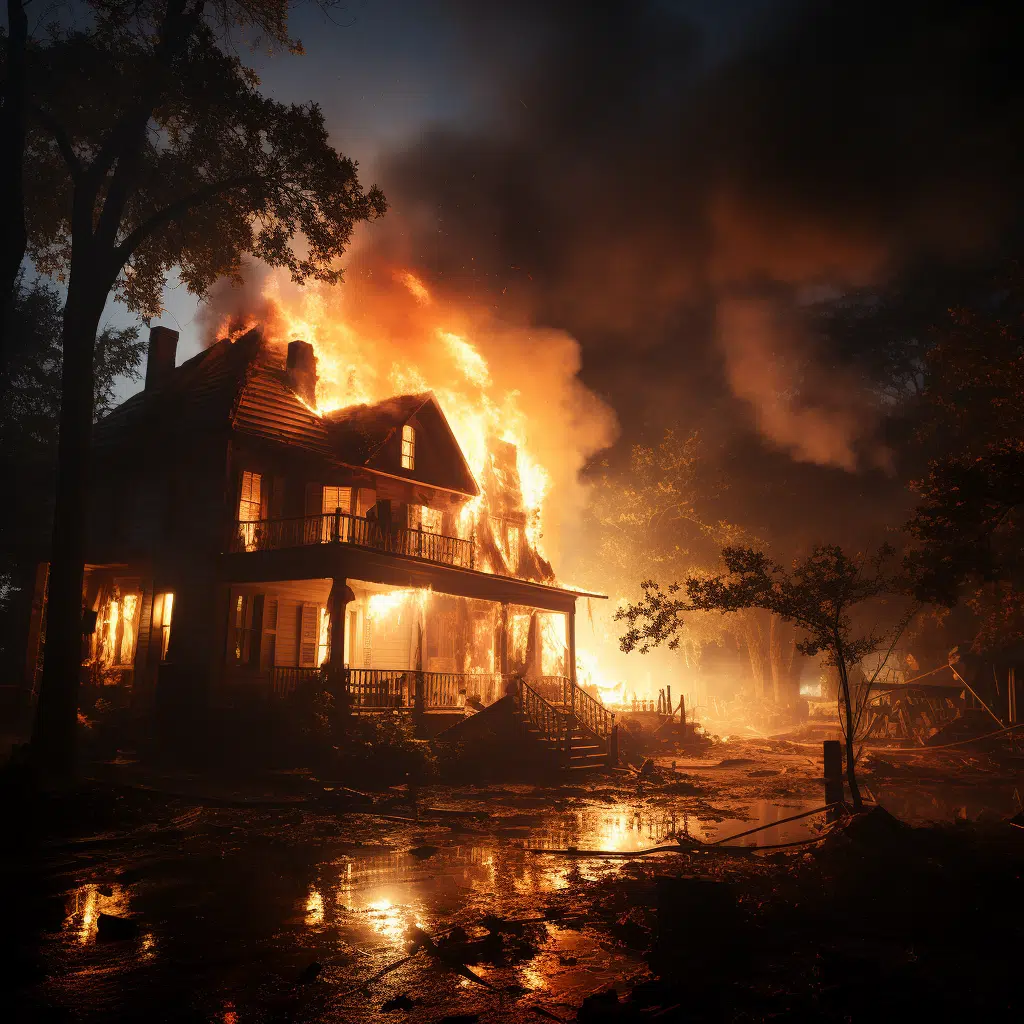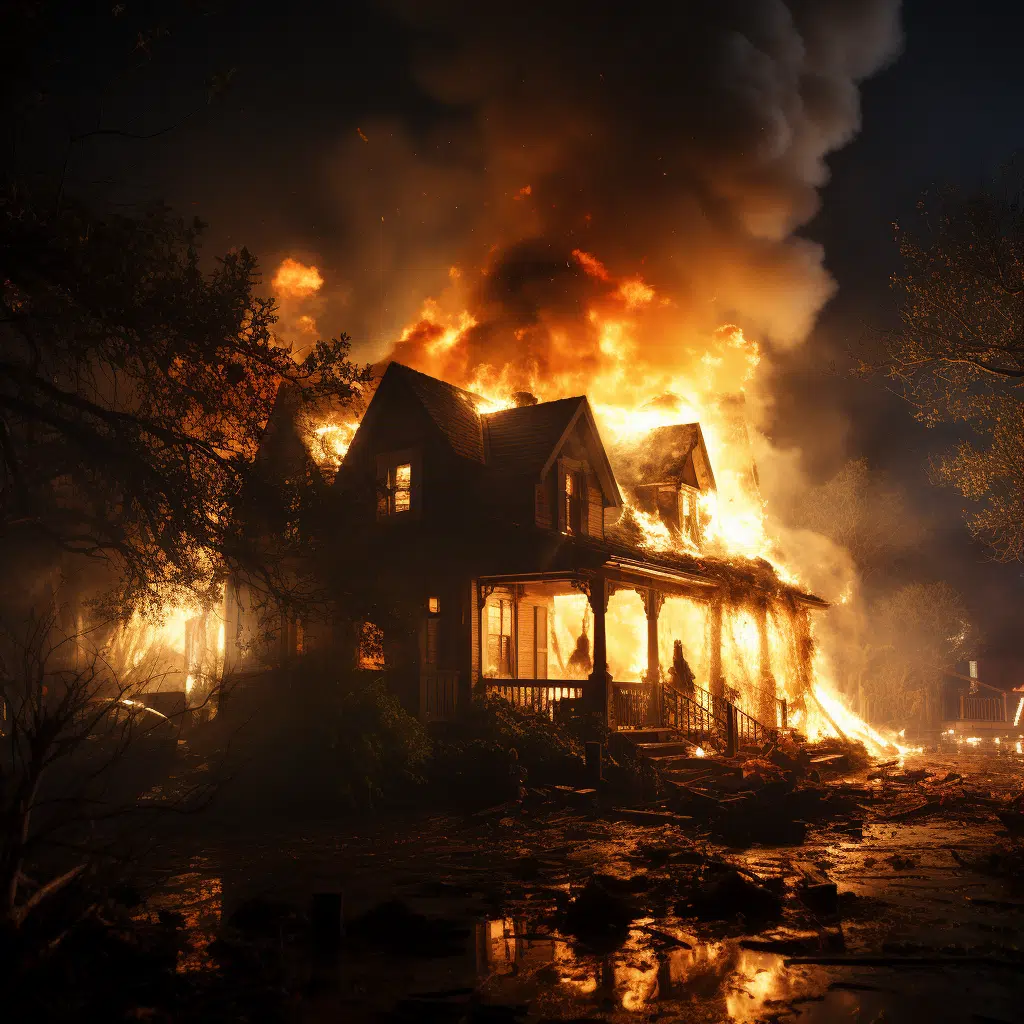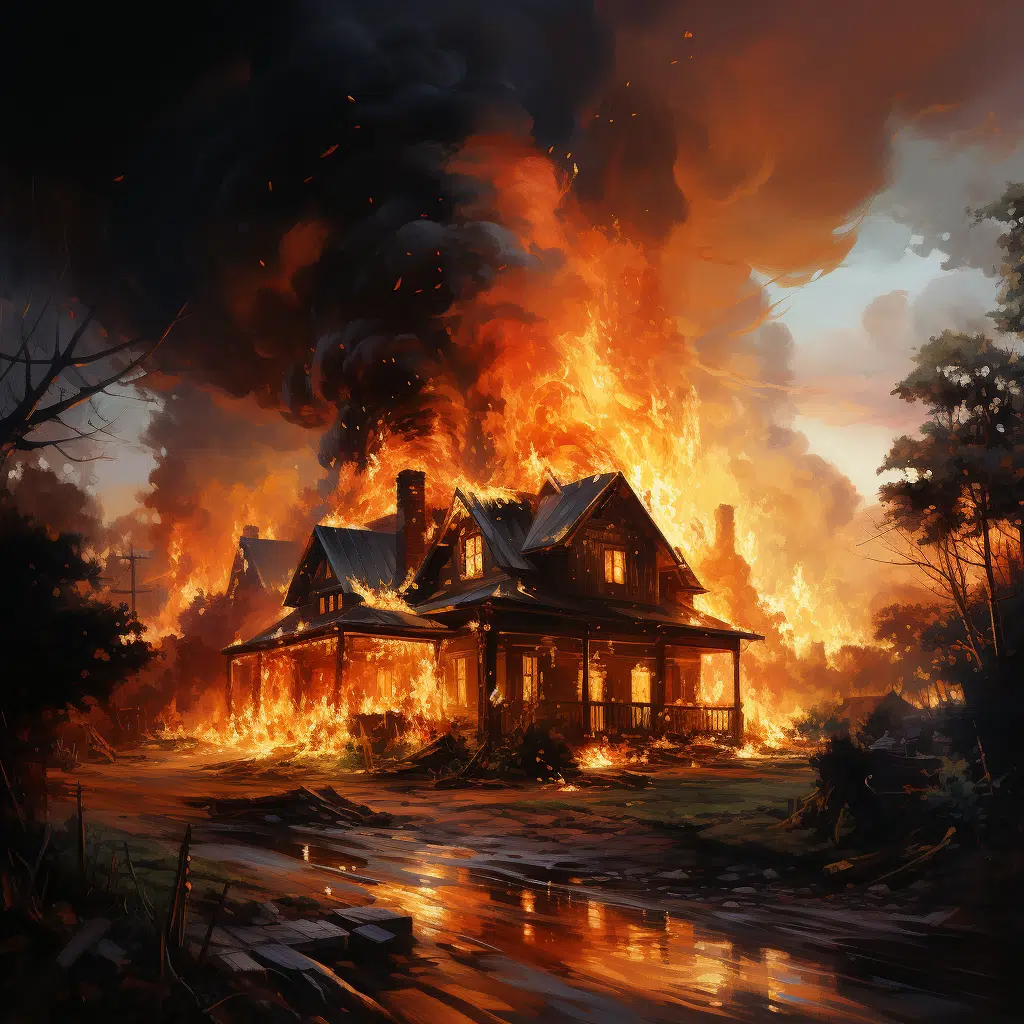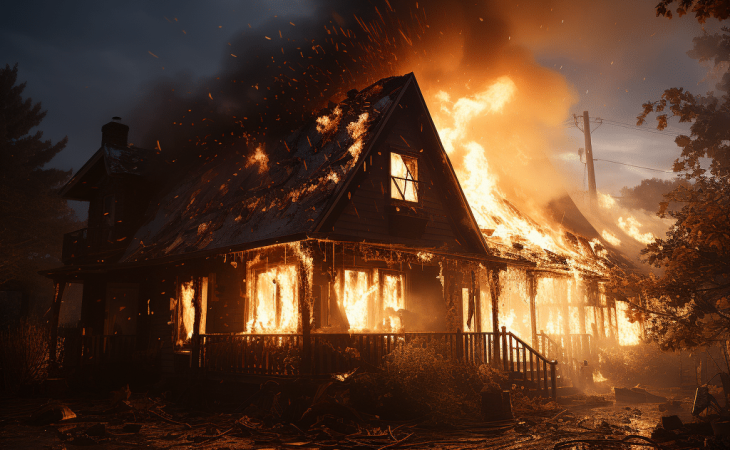Contents
House Fire Dangers: Swift and Deadly
House fires: a topic that’s often relegated to the background noise of everyday life, yet, when they strike, their impact is anything but ordinary. These blazes aren’t the slow burns of steady ambition we eulogize in the world of entrepreneurship; they are swift, they are deadly, and they aren’t to be underestimated. For the go-getters who strive to ascend the pinnacles of success, let this serve as a stark reminder that fire safety isn’t just an obligation—it’s a dire necessity.
The Lurking Threat: Understanding House Fire Statistics and Trends
The numbers are in, and they are as harrowing as they are enlightening. Recently, there’s been a see-saw in house fire statistics, with certain years seeing a spike while others a decline. What’s the deal? As it turns out, the shifting landscape of technology and lifestyle changes is playing a significant role.
Expert analysis suggests that the higher dependency on electronic gadgets could be contributing to a rise in fire incidents. An afternoon spent binge-watching Harry Melling Movies And TV Shows can be heaven, but overloaded circuits are a real hazard in our plugged-in paradise.
| Fire Development Timing | – Fire can spread from 30 seconds to minutes. |
| – Fully involved 1-story frame structure: fire knocked down in minutes (with adequate fire department response and water). | |
| Temperature Escalation | – Within 3 1/2 minutes, heat can exceed 1100 degrees Fahrenheit. |
| – Non-fire rooms can exceed 300 degrees, enough to melt plastic and lethal to occupants. | |
| Fatality Statistics | – About 80% of all civilian fire-related deaths occur at home. |
| Structural Impact | – Fire duration and damage depend on the structure, type, and extent of fire. |
| Firefighting Context | – Rapid response and adequate water supply are critical for swift firefighting. |
| Prevention | – Smoke alarms, fire extinguishers, and escape plans are crucial for survival. |
| – Regular maintenance of electrical systems and heating devices can prevent many fires. | |
| Economic Costs | – The average cost of a house fire is variable, depending on the extent of damage and location. |
| – Property loss, restoration, and temporary relocation contribute to the financial burden. | |
| Recovery | – Recovery time spans from immediate (minor fires) to years (major destruction), including both physical and emotional healing. |
| Insurance Considerations | – Insurance policies typically cover fires, but the extent of coverage varies. |
| – Prompt claim filing and accurate documentation are necessary for reimbursement. |
Analyzing the Most Common Causes of House Fires
Roll up your sleeves, because we’re about to get into the nitty-gritty. Faulty wiring is a notorious culprit—it’s the silent saboteur lurking behind your walls. And let’s not ignore that pot left on the stove; it’s not just your pasta on the line—it’s your life. Heating equipment, though meant to keep you cozy, can turn your abode into a furnace if left unchecked. These common causes are our cautionary tales, proving that a little negligence can lead to a whole lot of devastation.
With the advent of “smart” technology, we’ve got new heroes but also new risks. That I/o drawer of yours, while simplifying your life, may invite complexities you didn’t bargain for if not properly managed.

Talk about a reality check. Survivors recount their house fire ordeals with a clarity that chills to the bone. One moment, it’s the smell of Coach Slides left too close to the radiator, the next—a fight for life. They talk of how these experiences reshaped their outlook on fire safety. The takeaway?It’s not the heat, it’s the humility, as they’ve learned the hard way that it takes more than just a wish for safety to keep the flames at bay.
House Fire Safety Measures: Protecting Your Home and Loved Ones
Equip yourself and your sanctuary with an arsenal against the flames. Contemporary smoke detectors are more intuitive than ever—some can even differentiate between burnt toast and a real emergency. A reliable fire extinguisher? Non-negotiable. And those fire-resistant materials—they are the silent guardians in your walls, giving you a fighting chance against a blaze.
Researchers are adamant: these safety practices aren’t just effective—they are life-savers. The numbers don’t lie; homes equipped with proper safety measures see significantly lower rates of catastrophic fires. This is the kind of investment where returns are measured in lives preserved rather than dollars accrued.

Firefighting Frontlines: How Professionals Combat House Fires
When the siren sounds, it’s game time for our bravest. Firefighters rush into the inferno with precision and determination. Their tactics are as advanced as they are audacious. New technology plays a pivotal role—from high-pressure hoses that can slice through flames like a hot knife through butter to thermal imaging cameras that see through smoke, providing a beacon in the chaotic dark.
Fire safety professionals reveal that despite the prowess, residential fires present unique challenges—they’re confined, unpredictable, and personal. There’s no room for error when lives and memories are at stake.
The Financial and Emotional Aftermath of House Fires
Following a house fire, the smoke clears to reveal a financial and emotional battlefield. The costs pile up faster than the debris—renovations, replacements, and, of course, the formidable dragons named Deductibles and Premiums. Insurance is your knight in shining armor, but the battle for claims is often fraught with complexities that demand a steely resolve.
The hurt, though? That cuts deeper than any bill. Survivors of house fires speak of trauma that lingers long after the ashes have settled. However, amidst the ruin, there springs hope—support systems and recovery groups stand as pillars of resilience, showing that sometimes, the human spirit is the most fire-resistant material of all.
Future-Proofing Against Fire: Innovations in Home Construction
See that home being erected on your street? It’s a fortress in the making, thanks to advancements in fire-safe design. Cutting-edge materials that refuse to fuel flames and smart designs that starve fires before they grow are setting new standards in home construction.
The savvy architects and engineers behind these innovations see the bigger picture. It’s about crafting a space that stands as a testament to human ingenuity—a place where “Howl’s Moving Castle” book isn’t just a fascinating read but a metaphor for homes that can withstand the dragon’s breath.
The Role of Legislation in Reducing House Fire Incidences
Bureaucracy isn’t always red tape and paperwork—it can be a lifeline. Legislative changes focused on preventing house fires have the power to rewrite grim statistics. Codes and standards tighter than a drum have been instrumental in some regions, leading to a tangible drop in house fires.
Take note of stories coming out of these law-laden locales. They’re not just success stories; they’re blueprints for a safer society.
Community Initiative Triumphs: Local Success Stories in House Fire Reduction
From Main Street to your street, community initiatives have risen to the occasion, taming the beast that is the house fire. Educational campaigns that stick better than bunion Pads and local programs that draw engagement truths readers from every walk of life illustrate the paramount importance of awareness and action.
These victories aren’t just statistics—they’re narratives that weave themselves into the fabric of the community, proving that when it comes to fire safety, there’s strength in numbers.
The Integration of Technology in House Fire Detection and Response
Welcome to the era of smart homes, where your house not only listens but also watches over you. IoT devices have revolutionized the way we think about fire detection and response. Imagine being alerted to a fire hazard in your home with the same ease as catching the catchy “I want a hippopotamus for Christmas” lyrics—the tech is that intuitive.
The proof is in the pudding: these technological marvels are slashing house fire figures with the precision of a samurai. Lives are being saved, and peace of mind has found a new address.
Innovative Wrap-Up: Integrating Knowledge for Fire-Free Futures
From the ember to the inferno, the message is clear: fire safety is not an afterthought—it’s the foundation upon which secure futures are built. Brushing up on trends, arming ourselves with knowledge, and wholeheartedly embracing innovation will not only light the path to safety but will also safeguard our journeys as entrepreneurs.
So, let’s channel our inner Gary Vee and Tony Robbins: hustle like there’s no tomorrow, but protect today with the vigilance it deserves. The risk of house fires is omnipresent—swift and deadly—but armed with the right insight, our homes, dreams, and the lives within can emerge unscathed and victorious.
Unseen Dangers of House Fire
When you think of house fires, you might imagine a swift inferno, but often it’s the silent, unseen hazards that pose the greatest threats. Now, imagine if, like a scene right out of the “Howl’s Moving Castle book,” your home suddenly sprang to life, its structure groaning and shifting as if determined to save itself from the raging flames. It’s a captivating fantasy, yet in reality, house fires are no animated tale; they strike with a ferocity that allows little room for escape or whimsy. With over 350,000 house fires occurring in the United States every year, the importance of fire awareness cannot be overstated.
No Laughing Matter
Alright, let’s ease up a bit and delve into some quirky facts; did you know that, despite the grisly reality of house fires, some folks manage to find a spark of humor even in the face of danger? Take the classic holiday jingle, I Want a Hippopotamus For Christmas lyrics. It might leave you chuckling at the thought of a massive hippo managing the heat better than your average housecat during a fire. But speaking of critters, you’d be surprised how many times the brave firefighters report rescuing not just scared humans but also their furry friends who are engrossed in a bewildering Zoofilia of pets ranging from dogs to reptiles, all frantically trying to escape the smoky menace.
Out of the Frying Pan…
…and into the fire! Transitioning from the light-hearted to more sobering facts, house fires often claim more than homes; they gnaw at the very fabric of celebrity too. Remember the Kim Kardashian Leaked fiasco? Celebs like her have faced their share of emergencies, house fires included. It’s a stark reminder that fire doesn’t discriminate; it can blaze through a cozy cottage or a palatial estate with the same destructive appetite.
To wrap it up, visualizing a house fire as a monstrous creature or a dramatic storyline may seem like stretching the imagination, but it’s exactly such creative analogies that hammer in the point: house fires are swift, deadly, and indiscriminate. They don’t pause for a giggle at a Christmas carol nor bow down to stardom. Keep these facts in your back pocket – not only are they great conversation starters, but they also serve as a reminder of the seriousness of home safety. Keep your wits about you and your fire extinguisher handy.

What to do after a house fire checklist?
– Whoa, dealing with a house fire is a real doozy! First things first, make sure everyone’s safe, then dial up your insurance company to get that ball rolling. You’ll wanna find a safe place to stay, ’cause, you know, your pad’s kinda crispy. Contact family and friends to let ’em know you’re okay, and don’t go back into the house until the fire department says it’s safe. Grab your important docs if you can, and document everything for insurance. Lastly, take a deep breath, ’cause you’ve got a lot on your plate.
What do you give a family after a house fire?
– Gosh, when a family’s dealing with the aftermath of a house fire, they need more than just thoughts and prayers. Think essentials like clothes, toiletries, and a roof over their heads. Gift cards are a godsend, ’cause they can choose what they need most. Don’t forget about the kiddos – toys and books can be a real comfort. And hey, a homemade meal could be just the thing to warm their hearts (and bellies!).
How long does it take to put out a house fire?
– Alrighty, sticking to the facts, quenching a house fire isn’t a one-size-fits-all deal. It could be a quick few minutes or drag on for a week. If you’ve got a single-story home on fire, with the fire brigade on top of their game and plenty of agua, those flames could be history in just a handful of minutes. But let’s face it, things can get tricky, and it could take longer. Hang tight!
How hot does house fire get?
– Holy smokes, the heat from a house fire ain’t no joke – it can skyrocket to over 1100 degrees Fahrenheit in less than four minutes! And for those spots not even touched by flames? They can still get a scorching 300 degrees hot, enough to turn your vinyl records into a modern art installation!
What not to use after a house fire?
– Hold your horses and listen up! After a fire, dodge using utilities like electricity, gas, and water until the pros give you the thumbs up. Electronics and appliances? Treat ’em like they’re playing hot potato – they’re a no-go until they’re checked out. And food or drinks exposed to heat and smoke? Bin ’em, ’cause they’re not worth the risk.
What is safe to keep after a house fire?
– So, what’s safe to keep after a blaze? Well, it’s a bit of a gray area. Non-perishable items that escaped the inferno unscathed could be in the clear, but when in doubt, have a pro take a gander. Items without smoke or soot, and that haven’t been given a hotfoot, could be keepers, but trust your gut – if it seems off, it probably is!
How do I ask for donations after a house fire?
– Asking for help can be a tough pill to swallow, but here’s the skinny: Be honest and open when you’re in a jam. Start a crowdfunding page, and share your story ’cause folks want to support you. Reach out to your community through social media or local news, and don’t forget about local charities and organizations that can help spread the word.
How do you clean a house after a house fire?
– Cleaning a house post-fire is like trying to tidy up after a tornado – it’s intense! First, air the place out. Then, you’ll want to suit up like a superhero with gloves and masks. Begin with the salvageable stuff, giving it a good scrub with trusty cleaners. Walls, floors, and surfaces will need a deep clean to whisk away soot and smoke. When in doubt, give the pros a holler – they’ve got the magic touch for this sort of mess.
How do you emotionally recover from a house fire?
– Bouncing back from a house fire emotionally is like climbing a mountain – it’s tough, but you’ve got this. Chat it up with friends and family, and don’t be shy about joining support groups or snagging some time with a counselor. Give yourself permission to grieve and take it one day at a time. Remember, it’s okay to not be okay, and healing is a journey, not a race.
What is the #1 cause of house fires?
– Well, if we’re playing the blame game, cooking mishaps take the cake – they’re the #1 cause of house fires. Whether it’s a forgotten pot on the stove or a food-flambé gone wrong, the kitchen’s where most fires start. So, keep your eyes peeled when you’re whipping up your world-famous chili, okay?
What kills you first in a fire?
– It’s the smoke that’ll get you first in a fire, not the flames. Smoke inhalation can knock you off your feet faster than you can say “fire extinguisher,” filling your lungs with toxic fumes that can lead to the big sleep. So, always have a game plan to escape the smoke, like staying low to the ground and knowing your exits.
Can a house fire go out on its own?
– Can a house fire go out on its own? Sure, if you’re lucky and it’s a teeny tiny one. But don’t count on it! House fires usually want to go big or go home. Without a quick snuff from the fire department or lack of things to burn, that fire will party on. Better not to gamble and get those firefighters on the line, pronto.
How do you clean the air after a house fire?
– After a fiery fiasco, cleaning the air isn’t something to turn your nose up at. Start with good ventilation – open those windows wide! Then, bring in some air purifiers with HEPA filters to suck up that smoky air. If you’re feeling swamped, call in a cleanup crew. They’ve got the gear to clear the air and help you breathe easy.
Can you sleep in a house after a fire?
– Snoozing in your house after a fire? Not so fast! Even if it looks okay, there could be hidden damage or unhealthy air lurking around. Listen to the bigwigs – the fire department or a building inspector – to tell you when it’s safe to catch some Z’s at home again.
Do you have to rebuild the same house after a fire?
– After a fire throws you for a loop, rebuilding the same house isn’t a must-do; it’s more of a ‘could-do.’ Most times, insurance will cough up the cash to get you back on your feet, whether that’s with an old flame or a new spark. Check your policy and chatter with your agent to figure out the best way to rebuild your nest.
What does Servpro do after a fire?
– Servpro? Those guys are like the cleanup wizards after a fire. They swoop in faster than you can say “abracadabra” and get to work on the dirty job. They’ll give your place the old spit and polish, tackling soot, smoke, and water damage to make your house feel like a home again. Plus, they can help with those headaches of paperwork for the insurance claims.





